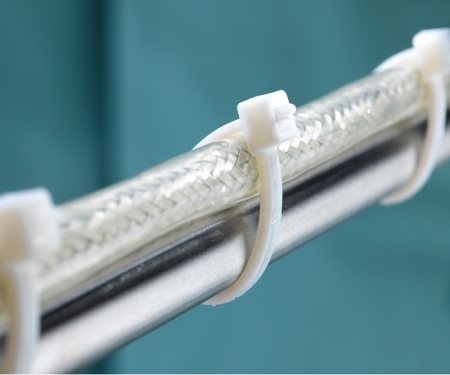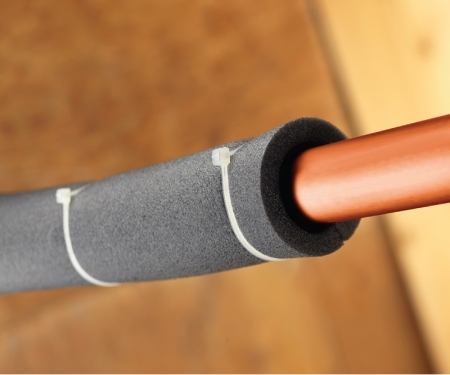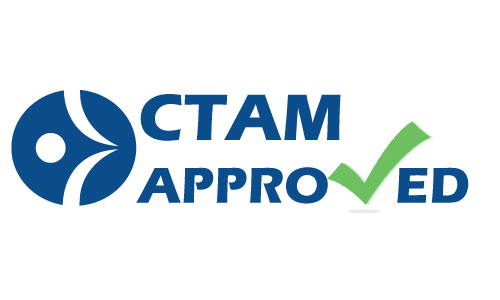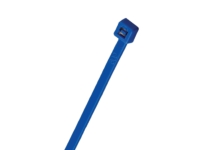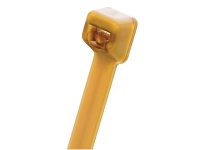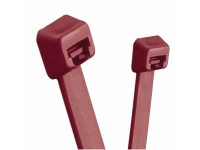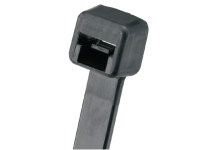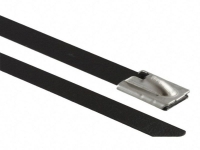(PVDF) Strong-Ty™ Kynar Cable Ties
Extreme Chemical Resistance & Highly Engineered, 100 & 1000 Packs
0.0 / 5
(PVDF) Strong-Ty™ Kynar Cable Ties Features
- Made from Kynar PVDF
- Excellent Resistance To Radiation & Mechanical Stress
- Plenum Rated: Meets NEC NFjPA-70A & UL94V-O
- Manufactured In USA Under Audited ISO 13485
- Manufactured & Packaged In Cleanroom Environment
- No Additives, Colorants Or Processing Are Added to the Kynar
- USP Class VI Compliant Polymer
- Full Material Traceability To Arkema
(PVDF) Strong-Ty™ Kynar Cable Ties achieve minimal flame-spread and smoke-generation, Strong-Ty™ zip ties meet the National Electrical Code (NFPA-70A) and UL94V-0 requirements for installation in building plenum. One of the advantages of PVDF cable ties is that they strengthen upon exposure to ionizing radiation. This also makes the Kynar cable ties an excellent choice for Medical applications where parts are exposed to a Cobalt 60 source for the purpose of sterilization. Strong-Ty™ Kynar cable ties made from PVDF are ideal for environments where combinations of high temperature, corrosion, radiation or mechanical stress limit other materials. These cable ties are durable and resist abrasion and mechanical damage during and after installation. Strong Ty™ cable ties are available in natural unpigmented Kynar® PVDF. These cable ties are ideal for corrosive process applications where test data shows that exposure to chemicals such as hydrochloric, sulfuric and hydrofluoric acids result in no loss of physical properties. Excellent non-flammability properties and heat resistance make these cable ties a better choice for organizing wires, cables and hoses in plenum spaces, under the hood and in appliance and computer cabinet interiors. Strong-Ty™ cable ties are durable and resist abrasion and mechanical damage during and after installation.
Are we missing the specification you need? Please go to our Contact Us page and submit your question to us, or call 1-877-284-7760
 | ||||||||||
| Part Number | A | B | C | D | E | F | G | Bundle Diameter | Min. Tensile | |
| Min | Max | |||||||||
| In. (mm) | In. (mm) | In. (mm) | In. (mm) | In. (mm) | In. (mm) | In. (mm) | In. (mm) | In. (mm) | lbs (N) | |
| CTNPC204N-C / M | 4 (102) | .179 (4.5) | .285 (7.25 | .22 (5.6) | .25 (6.4) | .182 (4.6) | .059 (1.5) | 0.13 (3.3) | 1 (25) | 48 (214) |
| CTNPC208N-C / M | 8 | .179 (4.5) | .285 (7.25 | .22 (5.6) | .25 (6.4) | 182 (4.6) | .059 (1.5) | 0.13 (3.3) | 2.25 | 48 (214) |
| Kynar® Material Properties | |||
| Physical Properties | Standards | Units | Results |
| Refractive Index | ASTM D542 | - | 1.42 |
| Specific Gravity | ASTM D742 | - | 1.77 - 1.80 |
| Water Absorption | ASTM D570 | % | 0.03 - 0.05 |
| Mechanical Properties | |||
| Flexural Strength at 5% Strain | ASTM D790 | psi | 3,000 - 5,000 |
| Flexural Modulus | ASTM D790 | psi | 150,000 - 180,000 |
| Tensile Yield Elongation | ASTM D638 | % | 5 - 15 |
| Tensile Yield Strength | ASTM D638 | psi | 4,500 - 6,000 |
| Tensile Break Elongation | ASTM D638 | % | 30 - 200 |
| Tensile Break Strength | ASTM D638 | psi | 4,000 - 7,000 |
| Tensile Modulus | ASTM D638 | psi | 150,000 - 220,000 |
| Deflection Temperature | ASTM D648 at 66 psi | °F | 140 - 167 |
| Hardness | ASTM D2240 | Shore D | 70 - 75 |
| Thermal Properties | |||
| Melting Temperature | ASTM D3418 | °F | 311 - 320 |
| Thermal Conductivity | ASTM D433 | BTU-in/hr.ft2 F | 1.0 - 1.25 |
| Electrical Properties | |||
| Dielectric Strength | ASTM D149 | KV/mil | 1.3 - 1.6 |
| Volume Resistivity | ASTM D257 | ohm-cm | 2 x 10 14 |
| Flame and Smoke Properties | |||
| Burning Rate | UL/Bulletin 94 | - | V - O |
| Limiting Oxygen Index | ASTM D2868 | % O2 | 43/75 |
| Kynar® Chemical Resistance | ||
| Chemical | Concentration | Maximum Temperature °F |
| Acetic Acid | 50% in water | 200 |
| Acetone | Not Recommended | |
| Brine | 275 | |
| Bromine, liquid | 150 | |
| Chlorine, liquid | 175 | |
| Chromic Acid | Up to 40% in water | 175 |
| Hydrochloric Acid | Up to "concentrated" | 275 |
| Hydrofluoric Acid | 41 - 100% | 200 |
| Nitric Acid | 11 - 70% in water | 150 |
| Phosphoric Acid | Less than 85% in water | 275 |
| Sulfuric Acid | Up to 60% in water | 250 |
Have a question that is not answered here? Please go to our Contact Us page and submit your question to us.
Looking for a quotation ? We would be happy to help by providing a quick response, inventory status, and Volume Level pricing, when available. Please fill out the form below and a representative will be in touch with you within hours to one business day to answer any questions and quote your request.
Product Details
(PVDF) Strong-Ty™ Kynar Cable Ties achieve minimal flame-spread and smoke-generation, Strong-Ty™ zip ties meet the National Electrical Code (NFPA-70A) and UL94V-0 requirements for installation in building plenum. One of the advantages of PVDF cable ties is that they strengthen upon exposure to ionizing radiation. This also makes the Kynar cable ties an excellent choice for Medical applications where parts are exposed to a Cobalt 60 source for the purpose of sterilization. Strong-Ty™ Kynar cable ties made from PVDF are ideal for environments where combinations of high temperature, corrosion, radiation or mechanical stress limit other materials. These cable ties are durable and resist abrasion and mechanical damage during and after installation. Strong Ty™ cable ties are available in natural unpigmented Kynar® PVDF. These cable ties are ideal for corrosive process applications where test data shows that exposure to chemicals such as hydrochloric, sulfuric and hydrofluoric acids result in no loss of physical properties. Excellent non-flammability properties and heat resistance make these cable ties a better choice for organizing wires, cables and hoses in plenum spaces, under the hood and in appliance and computer cabinet interiors. Strong-Ty™ cable ties are durable and resist abrasion and mechanical damage during and after installation.
Product Specifications
Are we missing the specification you need? Please go to our Contact Us page and submit your question to us, or call 1-877-284-7760
 | ||||||||||
| Part Number | A | B | C | D | E | F | G | Bundle Diameter | Min. Tensile | |
| Min | Max | |||||||||
| In. (mm) | In. (mm) | In. (mm) | In. (mm) | In. (mm) | In. (mm) | In. (mm) | In. (mm) | In. (mm) | lbs (N) | |
| CTNPC204N-C / M | 4 (102) | .179 (4.5) | .285 (7.25 | .22 (5.6) | .25 (6.4) | .182 (4.6) | .059 (1.5) | 0.13 (3.3) | 1 (25) | 48 (214) |
| CTNPC208N-C / M | 8 | .179 (4.5) | .285 (7.25 | .22 (5.6) | .25 (6.4) | 182 (4.6) | .059 (1.5) | 0.13 (3.3) | 2.25 | 48 (214) |
| Kynar® Material Properties | |||
| Physical Properties | Standards | Units | Results |
| Refractive Index | ASTM D542 | - | 1.42 |
| Specific Gravity | ASTM D742 | - | 1.77 - 1.80 |
| Water Absorption | ASTM D570 | % | 0.03 - 0.05 |
| Mechanical Properties | |||
| Flexural Strength at 5% Strain | ASTM D790 | psi | 3,000 - 5,000 |
| Flexural Modulus | ASTM D790 | psi | 150,000 - 180,000 |
| Tensile Yield Elongation | ASTM D638 | % | 5 - 15 |
| Tensile Yield Strength | ASTM D638 | psi | 4,500 - 6,000 |
| Tensile Break Elongation | ASTM D638 | % | 30 - 200 |
| Tensile Break Strength | ASTM D638 | psi | 4,000 - 7,000 |
| Tensile Modulus | ASTM D638 | psi | 150,000 - 220,000 |
| Deflection Temperature | ASTM D648 at 66 psi | °F | 140 - 167 |
| Hardness | ASTM D2240 | Shore D | 70 - 75 |
| Thermal Properties | |||
| Melting Temperature | ASTM D3418 | °F | 311 - 320 |
| Thermal Conductivity | ASTM D433 | BTU-in/hr.ft2 F | 1.0 - 1.25 |
| Electrical Properties | |||
| Dielectric Strength | ASTM D149 | KV/mil | 1.3 - 1.6 |
| Volume Resistivity | ASTM D257 | ohm-cm | 2 x 10 14 |
| Flame and Smoke Properties | |||
| Burning Rate | UL/Bulletin 94 | - | V - O |
| Limiting Oxygen Index | ASTM D2868 | % O2 | 43/75 |
| Kynar® Chemical Resistance | ||
| Chemical | Concentration | Maximum Temperature °F |
| Acetic Acid | 50% in water | 200 |
| Acetone | Not Recommended | |
| Brine | 275 | |
| Bromine, liquid | 150 | |
| Chlorine, liquid | 175 | |
| Chromic Acid | Up to 40% in water | 175 |
| Hydrochloric Acid | Up to "concentrated" | 275 |
| Hydrofluoric Acid | 41 - 100% | 200 |
| Nitric Acid | 11 - 70% in water | 150 |
| Phosphoric Acid | Less than 85% in water | 275 |
| Sulfuric Acid | Up to 60% in water | 250 |
Product Manuals
Frequently Asked Questions
Have a question that is not answered here? Please go to our Contact Us page and submit your question to us.




